+ Open data
Open data
- Basic information
Basic information
| Entry | Database: PDB / ID: 6h2b | |||||||||
|---|---|---|---|---|---|---|---|---|---|---|
| Title | Structure of the Macrobrachium rosenbergii Nodavirus | |||||||||
 Components Components | Capsid protein | |||||||||
 Keywords Keywords | VIRUS LIKE PARTICLE / Nodavirus / Capsid / Virion | |||||||||
| Function / homology | virion component / Viral coat protein subunit / Capsid protein alpha Function and homology information Function and homology information | |||||||||
| Biological species |  Macrobrachium rosenbergii nodavirus Macrobrachium rosenbergii nodavirus | |||||||||
| Method | ELECTRON MICROSCOPY / single particle reconstruction / cryo EM / Resolution: 3.28 Å | |||||||||
 Authors Authors | Ho, K.H. / Gabrielsen, M. / Beh, P.L. / Kueh, C.L. / Thong, Q.X. / Streetley, J. / Tan, W.S. / Bhella, D. | |||||||||
| Funding support |  United Kingdom, United Kingdom,  Malaysia, 2items Malaysia, 2items
| |||||||||
 Citation Citation |  Journal: PLoS Biol / Year: 2018 Journal: PLoS Biol / Year: 2018Title: Structure of the Macrobrachium rosenbergii nodavirus: A new genus within the Nodaviridae? Authors: Kok Lian Ho / Mads Gabrielsen / Poay Ling Beh / Chare Li Kueh / Qiu Xian Thong / James Streetley / Wen Siang Tan / David Bhella /   Abstract: Macrobrachium rosenbergii nodavirus (MrNV) is a pathogen of freshwater prawns that poses a threat to food security and causes significant economic losses in the aquaculture industries of many ...Macrobrachium rosenbergii nodavirus (MrNV) is a pathogen of freshwater prawns that poses a threat to food security and causes significant economic losses in the aquaculture industries of many developing nations. A detailed understanding of the MrNV virion structure will inform the development of strategies to control outbreaks. The MrNV capsid has also been engineered to display heterologous antigens, and thus knowledge of its atomic resolution structure will benefit efforts to develop tools based on this platform. Here, we present an atomic-resolution model of the MrNV capsid protein (CP), calculated by cryogenic electron microscopy (cryoEM) of MrNV virus-like particles (VLPs) produced in insect cells, and three-dimensional (3D) image reconstruction at 3.3 Å resolution. CryoEM of MrNV virions purified from infected freshwater prawn post-larvae yielded a 6.6 Å resolution structure, confirming the biological relevance of the VLP structure. Our data revealed that unlike other known nodavirus structures, which have been shown to assemble capsids having trimeric spikes, MrNV assembles a T = 3 capsid with dimeric spikes. We also found a number of surprising similarities between the MrNV capsid structure and that of the Tombusviridae: 1) an extensive network of N-terminal arms (NTAs) lines the capsid interior, forming long-range interactions to lace together asymmetric units; 2) the capsid shell is stabilised by 3 pairs of Ca2+ ions in each asymmetric unit; 3) the protruding spike domain exhibits a very similar fold to that seen in the spikes of the tombusviruses. These structural similarities raise questions concerning the taxonomic classification of MrNV. | |||||||||
| History |
|
- Structure visualization
Structure visualization
| Movie |
 Movie viewer Movie viewer |
|---|---|
| Structure viewer | Molecule:  Molmil Molmil Jmol/JSmol Jmol/JSmol |
- Downloads & links
Downloads & links
- Download
Download
| PDBx/mmCIF format |  6h2b.cif.gz 6h2b.cif.gz | 329.1 KB | Display |  PDBx/mmCIF format PDBx/mmCIF format |
|---|---|---|---|---|
| PDB format |  pdb6h2b.ent.gz pdb6h2b.ent.gz | 271.1 KB | Display |  PDB format PDB format |
| PDBx/mmJSON format |  6h2b.json.gz 6h2b.json.gz | Tree view |  PDBx/mmJSON format PDBx/mmJSON format | |
| Others |  Other downloads Other downloads |
-Validation report
| Summary document |  6h2b_validation.pdf.gz 6h2b_validation.pdf.gz | 734.8 KB | Display |  wwPDB validaton report wwPDB validaton report |
|---|---|---|---|---|
| Full document |  6h2b_full_validation.pdf.gz 6h2b_full_validation.pdf.gz | 740.2 KB | Display | |
| Data in XML |  6h2b_validation.xml.gz 6h2b_validation.xml.gz | 41.4 KB | Display | |
| Data in CIF |  6h2b_validation.cif.gz 6h2b_validation.cif.gz | 61.3 KB | Display | |
| Arichive directory |  https://data.pdbj.org/pub/pdb/validation_reports/h2/6h2b https://data.pdbj.org/pub/pdb/validation_reports/h2/6h2b ftp://data.pdbj.org/pub/pdb/validation_reports/h2/6h2b ftp://data.pdbj.org/pub/pdb/validation_reports/h2/6h2b | HTTPS FTP |
-Related structure data
| Related structure data |  0129MC  0130C M: map data used to model this data C: citing same article ( |
|---|---|
| Similar structure data | |
| EM raw data |  EMPIAR-10203 (Title: Structure of the Macrobrachium rosenbergii Nodavirus: A new genus within the Nodaviridae? EMPIAR-10203 (Title: Structure of the Macrobrachium rosenbergii Nodavirus: A new genus within the Nodaviridae?Data size: 130.4 Data #1: Motion corrected micrographs of Macrobrachium rosenbergii nodavirus virus-like particles [micrographs - single frame]) |
- Links
Links
- Assembly
Assembly
| Deposited unit | 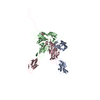
|
|---|---|
| 1 | x 60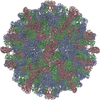
|
| 2 |
|
| 3 | x 5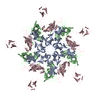
|
| 4 | x 6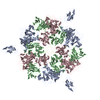
|
| 5 | 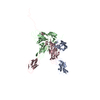
|
| Symmetry | Point symmetry: (Schoenflies symbol: I (icosahedral)) |
- Components
Components
| #1: Protein | Mass: 41563.594 Da / Num. of mol.: 3 Source method: isolated from a genetically manipulated source Source: (gene. exp.)  Macrobrachium rosenbergii nodavirus / Gene: CP / Production host: Macrobrachium rosenbergii nodavirus / Gene: CP / Production host:  #2: Chemical | ChemComp-CA / |
|---|
-Experimental details
-Experiment
| Experiment | Method: ELECTRON MICROSCOPY |
|---|---|
| EM experiment | Aggregation state: PARTICLE / 3D reconstruction method: single particle reconstruction |
- Sample preparation
Sample preparation
| Component | Name: Macrobrachium rosenbergii nodavirus / Type: VIRUS / Details: Capsid protein was expressed in Sf9 cells / Entity ID: #1 / Source: RECOMBINANT |
|---|---|
| Molecular weight | Experimental value: NO |
| Source (natural) | Organism:  Macrobrachium rosenbergii nodavirus Macrobrachium rosenbergii nodavirus |
| Source (recombinant) | Organism:  |
| Details of virus | Empty: NO / Enveloped: NO / Isolate: OTHER / Type: VIRUS-LIKE PARTICLE |
| Natural host | Organism: Macrobrachium rosenbergii |
| Virus shell | Name: Capsid / Diameter: 400 nm / Triangulation number (T number): 3 |
| Buffer solution | pH: 7.4 / Details: 20 mM HEPES, 100 mM NaCl pH 7.4 |
| Specimen | Conc.: 0.2 mg/ml / Embedding applied: NO / Shadowing applied: NO / Staining applied: NO / Vitrification applied: YES |
| Specimen support | Grid material: COPPER / Grid mesh size: 400 divisions/in. / Grid type: Quantifoil R2/2 |
| Vitrification | Cryogen name: ETHANE / Humidity: 100 % / Chamber temperature: 277 K Details: VLPs were deposited onto a continuous carbon film that had been floated onto a quantifoil holey carbon film (R2/2) |
- Electron microscopy imaging
Electron microscopy imaging
| Experimental equipment |  Model: Titan Krios / Image courtesy: FEI Company |
|---|---|
| Microscopy | Model: FEI TITAN KRIOS |
| Electron gun | Electron source:  FIELD EMISSION GUN / Accelerating voltage: 300 kV / Illumination mode: FLOOD BEAM FIELD EMISSION GUN / Accelerating voltage: 300 kV / Illumination mode: FLOOD BEAM |
| Electron lens | Mode: BRIGHT FIELD / Calibrated magnification: 47170 X / Nominal defocus max: 2500 nm / Nominal defocus min: 1000 nm / Alignment procedure: COMA FREE |
| Specimen holder | Cryogen: NITROGEN / Specimen holder model: FEI TITAN KRIOS AUTOGRID HOLDER |
| Image recording | Average exposure time: 5 sec. / Electron dose: 36 e/Å2 / Detector mode: COUNTING / Film or detector model: GATAN K2 QUANTUM (4k x 4k) / Num. of grids imaged: 1 / Num. of real images: 2459 |
| EM imaging optics | Energyfilter name: GIF Bioquantum / Energyfilter slit width: 20 eV |
| Image scans | Movie frames/image: 20 / Used frames/image: 2-20 |
- Processing
Processing
| Software | Name: PHENIX / Version: 1.11.1_2575: / Classification: refinement | ||||||||||||||||||||||||||||||||||||
|---|---|---|---|---|---|---|---|---|---|---|---|---|---|---|---|---|---|---|---|---|---|---|---|---|---|---|---|---|---|---|---|---|---|---|---|---|---|
| EM software |
| ||||||||||||||||||||||||||||||||||||
| CTF correction | Type: PHASE FLIPPING AND AMPLITUDE CORRECTION | ||||||||||||||||||||||||||||||||||||
| Particle selection | Num. of particles selected: 60939 / Details: Automated particle picking in Relion 2.1 | ||||||||||||||||||||||||||||||||||||
| Symmetry | Point symmetry: I (icosahedral) | ||||||||||||||||||||||||||||||||||||
| 3D reconstruction | Resolution: 3.28 Å / Resolution method: FSC 0.143 CUT-OFF / Num. of particles: 40883 / Algorithm: BACK PROJECTION / Details: Standard Relion workflow for icosahedral particle. / Symmetry type: POINT | ||||||||||||||||||||||||||||||||||||
| Atomic model building | B value: 140 / Protocol: AB INITIO MODEL / Space: REAL Details: Model built largely ab initio, following docking of a homology model based on PDB 4LLF. The homology model matched in two strands at residues - 104-135 and 232-243. This served as the ...Details: Model built largely ab initio, following docking of a homology model based on PDB 4LLF. The homology model matched in two strands at residues - 104-135 and 232-243. This served as the starting point for manual model building. The model was then subjected to real space refinement using Phenix. | ||||||||||||||||||||||||||||||||||||
| Refine LS restraints |
|
 Movie
Movie Controller
Controller




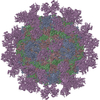
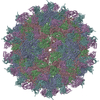
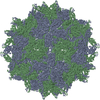
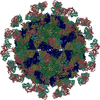
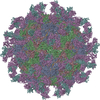
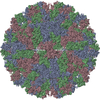
 PDBj
PDBj

